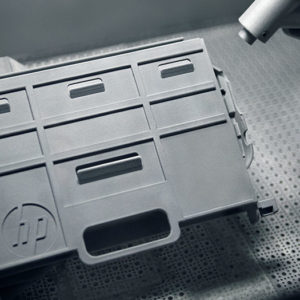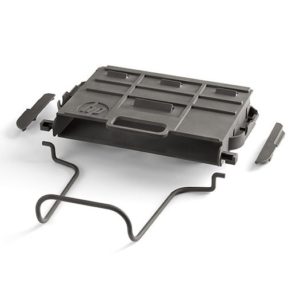 It’s been three years since the first 3D printer was sent to the International Space Station, becoming the first 3D printer ever to be launched into space. But the astronauts aboard the ISS have been printing in space for much longer than that – 2D printing, that is. The ISS has had 2D printers ever since the beginning. The astronauts use them to print out everything from critical mission information to photos sent from home. There are two printers on board, one on the US side and one on the Russian side.
It’s been three years since the first 3D printer was sent to the International Space Station, becoming the first 3D printer ever to be launched into space. But the astronauts aboard the ISS have been printing in space for much longer than that – 2D printing, that is. The ISS has had 2D printers ever since the beginning. The astronauts use them to print out everything from critical mission information to photos sent from home. There are two printers on board, one on the US side and one on the Russian side.
The problem is that not only has the ISS had printers since its beginnings in 2000, but it’s had the same printers since its beginnings in 2000. Not the exact same machines, but the same model – an Epson 800 Inkjet printer from HP.
“It’s a museum piece,” said Stephen Hunter, Manager of International Space Station Computer Resources.
Hunter has been working on updating the ISS’ office technology for the last two years, and HP has helped, providing new Gen 2 Z-Book laptops, so NASA turned to them again for help with obtaining a new printer. This is easier said than done – you can’t just pull a printer off the shelf and ship it off to space. Printers are overall ill-suited for micro-gravity, with large amounts of power consumption and elements such as toner dust that won’t survive the environment.
NASA wanted a printer that was flame retardant and power efficient, could print and handle paper management in zero gravity, and could handle ink waste during printing.
“We couldn’t pass up the opportunity to do this. It was an incredible technical challenge,” said Enrique Lores, President of HP’s Imaging, Printing and Solutions business.
 Since electricity on the ISS is generated by solar panels, power consumption has to be carefully managed, and there were several zero gravity issues to take into consideration. For instance, printers normally deposit a bit of extra ink when printing. Ordinarily, that ink stays in the printer or on the page, where it ends up drying. But in zero gravity, that ink floats away where it can be inhaled or contaminate experiments. Paper, too, needed to be somehow held down so it didn’t float away or jam the printer.
Since electricity on the ISS is generated by solar panels, power consumption has to be carefully managed, and there were several zero gravity issues to take into consideration. For instance, printers normally deposit a bit of extra ink when printing. Ordinarily, that ink stays in the printer or on the page, where it ends up drying. But in zero gravity, that ink floats away where it can be inhaled or contaminate experiments. Paper, too, needed to be somehow held down so it didn’t float away or jam the printer.
HP recommended the HP Envy 5600, but it would need some major modifications. A team of HP and NASA personnel worked together to figure out which parts of the printer would be affected by zero gravity and how they would need to be changed. For example, the printer carriage hangs from a rod and is pulled into place by gravity. That wouldn’t work on the ISS, so HP came up with a mechanism that would do the work of gravity.
3D printing came into play, as HP used the technology to create complex new parts – not the first time the company has looked to its own 3D printing capabilities to enhance its own printers, both Multi Jet Fusion 3D printers and its 2D inkjet printers. The multiple components that make up the Envy printer output tray, for instance, were 3D printed, making the piece more flexible and lightweight. They even used an experimental new material, a nylon filled with glass beads, whose development was expedited for use in this project
“It’s a showcase for us to be able to combine all of our efforts as one HP,” said Pat Harnett, Director of Engineering, Specialty Printing Systems.
- 3D printing the input tray
- Sand blasting 3D printed parts
- The 3D printed output tray
In addition, HP and NASA removed the printer’s capability to fax, scan and copy, making it more lightweight and removing glass. They added several fasteners, replaced the shell with fire-retardant plastic and added absorbing material in the print well to catch excess ink. The final result was the HP Envy Zero-Gravity printer, a customized machine that would perform in zero gravity – which was confirmed on a series of parabolic flights.
“Through the creative ingenuity of HP’s SPS team and access to HP’s MultiJet Fusion 3D printing technology, we were able to design and produce complex parts that ensured the HP ENVY Zero-Gravity Printer successfully met all of NASA’s requirements,” said Lores.
NASA plans to send two of the printers up to the ISS on a resupply mission in February 2018 via the Space-X 14 rocket.
“The most exciting part is yet to come,” said 3D MJS Lab Lead Technician Ben Moore, “when we are done and can send this thing up into space.”
NASA and HP have created about 50 of the tweaked Envy printers and expect each one to last about two years.
Discuss this and other 3D printing topics at 3DPrintBoard.com or share your thoughts in the Facebook comments below.
[Sources: Mashable, HP / Images: HP]
Subscribe to Our Email Newsletter
Stay up-to-date on all the latest news from the 3D printing industry and receive information and offers from third party vendors.
You May Also Like
3D Printing Unpeeled: Biofuel Waste to Filament & Sustainable Photopolymers
I can’t ever remember a day with so many potentially high impact news stories have come out. In one story, we all know that there are problems with the safety...
Finnair Hires AM Craft to 3D Print Plastic Parts for Aircraft Interiors
Riga-based AM Craft, a supplier specialized in 3D printing aviation components and certified under EASA Part 21G, announced a significant achievement today. The company will assist in upgrading Finnair’s A320...
3DPOD Episode 198: High Speed Sintering with Neil Hopkinson, VP of AM at Stratasys
Neil Hopkinson, a pioneering 3D printing researcher, played a pivotal role in developing a body of research that is widely utilized today. He also invented High Speed Sintering (HSS), also...
3D Printing Webinar and Event Roundup: May 12, 2024
Webinars and events are picking up in the AM industry this week! ASTM International continues its Professional Certificate Course and Stratasys continues its advanced in-person trainings, while 3D Systems is...




































